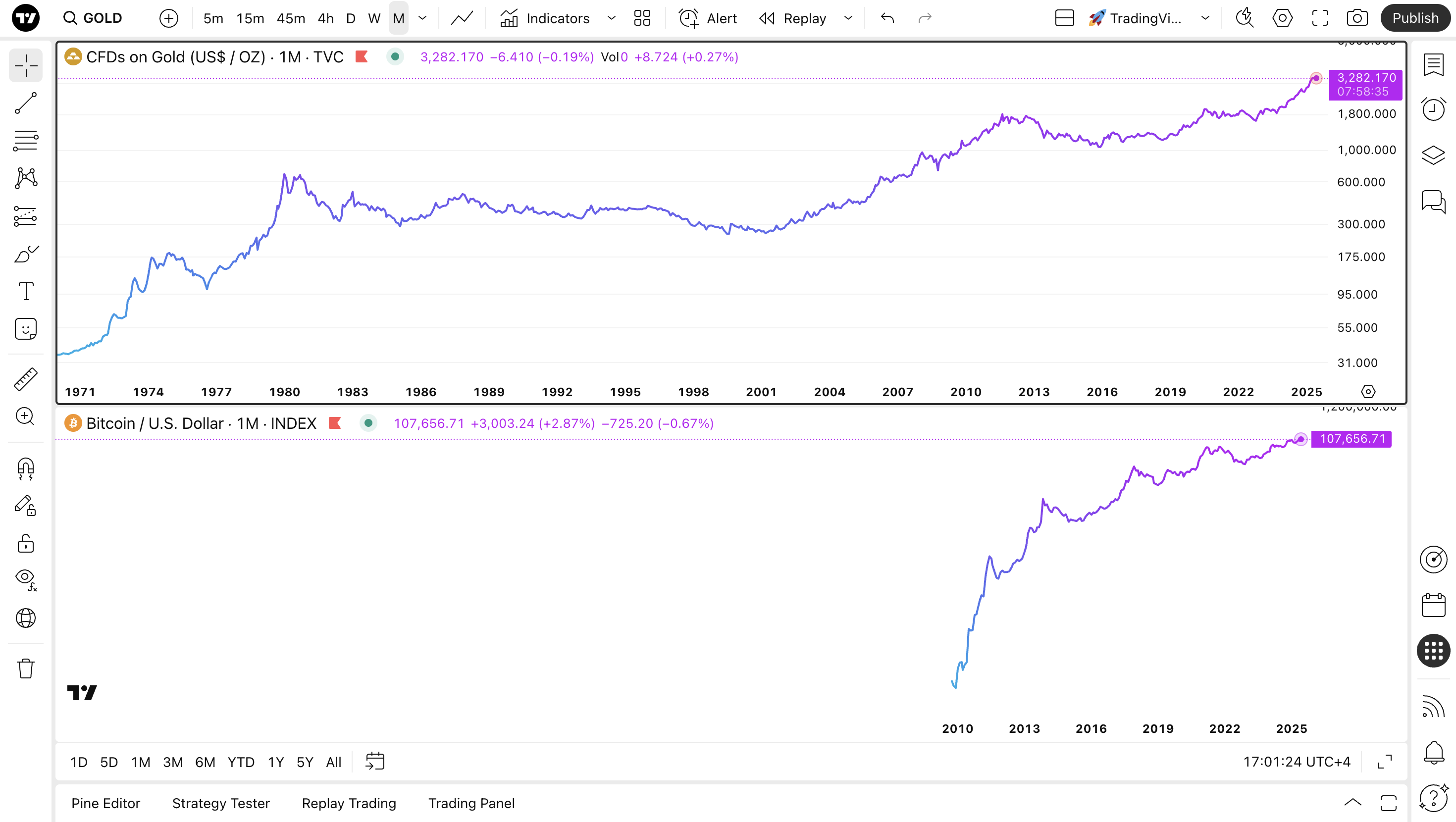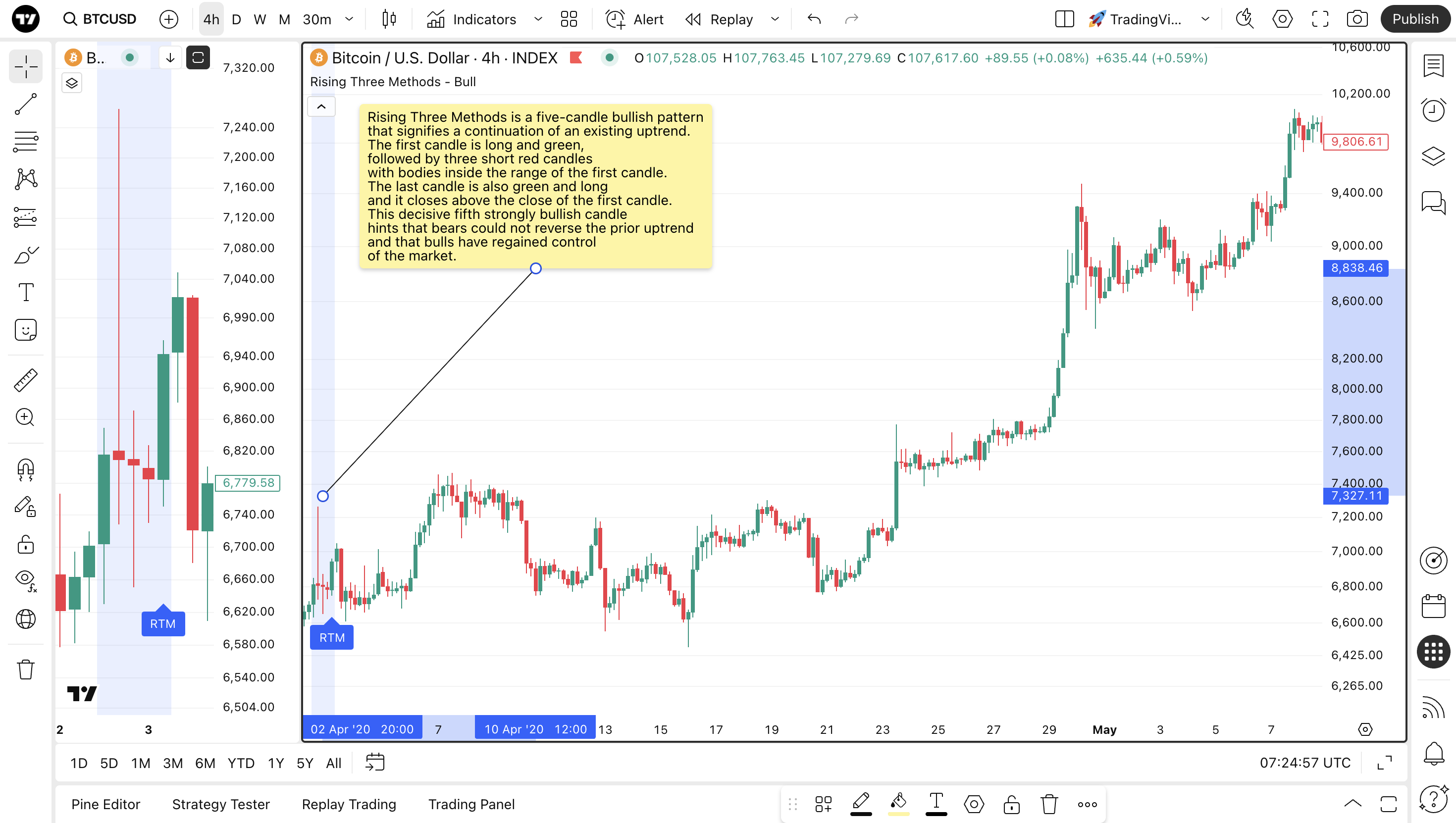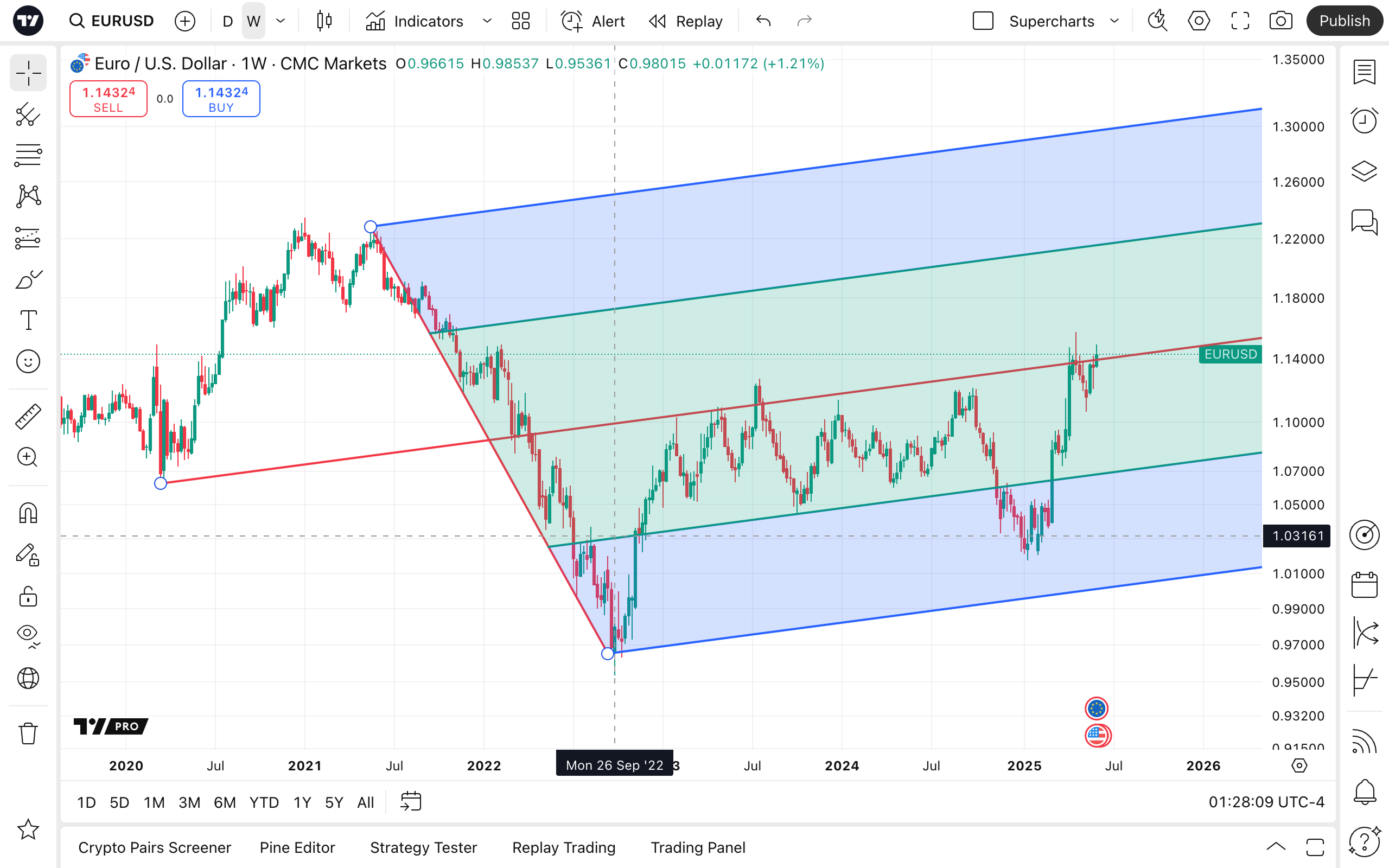TradingView ile teknik analizin temelleri
Teknik analiz, bir varlığın fiyatının belirli bir yönde hareket etme ve belirli seviyelere ulaşma olasılığını değerlendirmek için kullanılan bir yaklaşımdır. Analistler, borsalardan gelen fiyat ve hacim verilerini görselleştirmek ve incelemek için Süpergrafikleri ve çeşitli araçları kullanır.
İÇİNDEKİLER:
- Teknik analiz nedir
- Teknik analiz ve temel analiz
- Teknik analizin temel bileşenleri
- TradingView teknik analiz özellikleri
Teknik analiz nedir
Teknik analistler geçmişi inceleyerek geleceği tahmin edebileceğimizi varsayarlar, ama bu doğru mu ve işe yarıyor mu? Teknik analizin ne olduğunu ve fiyat hareketlerinde gezinmek için nasıl kullanabileceğinizi inceleyelim.
Teknik analistler, bu analizin sunduğu araçlarla kullanılan birincil görselleştirme tekniği grafikler olduğu için grafiker olarak da adlandırılır.
Grafikerler farklı grafik türleri kullanır, grafik formasyonları arar ve bilinçli kararlar almak ve zamanında işlem yapmak için TradingView Alarmları kurar.
Teknik analizin dayandığı iki temel bileşen fiyat ve işlem hacmidir.
Teknik göstergeler fiyat ve hacim arasındaki ilişkilere, çeşitli fiyat noktalarına ve fiyatların zaman içinde değişme hızına, yani volatiliteye ve çok daha fazlasına dayalı olarak oluşturulabilir.
"Düşüşü satın almak" için en iyi giriş noktalarını ve "yükselişi satmak" için çıkış noktalarını bulmak için grafikerlerin kullandığı teknik analizin temel bileşenlerini ve işlem araçlarını inceleyeceğiz.
Teknik analizin temel faydası, farklı tahmin dönemleri ve varlıklar için kullanılabilmesidir. Yatırımcılar bunu hem uzun vadeli yatırım hem de kısa vadeli alım satım için kullanabilirler.
Geniş bir yelpazedeki teknik enstrümanlar ve teknikler, yatırımcıların kendi benzersiz işlem stratejilerini bulmalarına yardımcı olur.
Örneğin, yatırımcılar 5 dakikalık mum grafiğinde kısa vadeli alım satım yapabilir veya yatırım için aylık çizgi grafiklerini inceleyebilirler - her ikisi de farklı göstergeler ve çizim araçları ile.
Ancak, bazı varlıklar henüz yeterince gelişmediği için bazı teknik araç ve gereçleri kullanmanın sınırlamaları vardır.
Örneğin, Bitcoin'i aylık bir zaman diliminde analiz etmek, aynı girdilerle altın kadar bilgilendirici olmayacaktır.

Bu tür hataların olasılığını en aza indirmek için, bir varlığın performansını analiz ederek fiyatlarındaki tutarsızlıkları bulmanıza yardımcı olan grafik teknikleri vardır.
Bunlardan biri, analitik bir perspektiften bakıldığında bunu yapmak için geçerli bir neden olmamasına rağmen, bazı yatırımcıların bir varlığı satın aldığı fiyatları belirlemeye yardımcı olan mum grafiğidir.
Piyasa duyarlılığını ölçmek için grafikerler, teknik analiz kamuoyunun ilgisindeki değişimleri tespit etmek için bu verileri içerebildiğinden, sosyal medyadaki varlıkların sözlerini yakından inceler.
Bu nedenle, teknik analiz sadece kalın sayılardan ibaret değildir - bir varlığın çekiciliğini farklı açılardan değerlendirmede bir adım ötesidir. Ancak, temel metrikleri inceledikten sonra kullanıldığında en iyi sonucu verir.
Teknik analiz ve temel analiz
Bugün, teknik analiz ve temel analiz taraftarları arasında büyük bir savaş yok. Bir arada varlar ve yatırımcılar genellikle her iki yöntemi de kullanırlar.
Temel analizin temel amacı, bir varlığın mevcut fiyatının adil olup olmadığını ve içsel değeriyle ilişkili olup olmadığını değerlendirmektir. Tahminleri için ana kaynak olarak bir şirketin kazançlar, temettüler ve hisse bölünmeleri gibi finansal verilerini kullanır.
Kripto para birimlerinde, raporları incelenebilecek bir şirket (Bitcoin'de olduğu gibi) olmayabilir. Ancak, her ikisi de dolaşımdaki arz, piyasa değerine göre hakimiyet ve tamamen seyreltilmiş değerleme (FDV) gibi coinlerin ve tokenlerin temellerini inceleyen tokenomik ve değerleme çerçeveleri vardır.
Madencilerin eskiden aldıkları ödülün yarısını almaya başladıkları halving gibi bir coinin fiyatını etkileyen olaylar olabilir.
Ayrıca, bir kripto para biriminin ekonomik ve teknik yönlerini özetleyen temel belgeleri olan whitepaper'lar da vardır.
Bildiğiniz gibi, teknik analiz daha kısa zaman aralıklarında daha kesindir. Yatırımcıların işlemleri için giriş ve çıkış noktalarını bulmalarına yardımcı olmakta vazgeçilmezdir.
Ancak bir şirketin canlılığını ve belirli gerçek dünya koşulları altında nasıl performans göstereceğini tahmin etmeye gelince, temel analiz tercih edilen seçenektir.
Yaygın bir yaklaşım şudur: Önce temel analiz / Sonra teknik analiz.
Teknik analizin temel bileşenleri
Grafik çizimi, alım satımı yapılabilir varlıkların kapsamlı bir çalışmasıdır. Bunları analiz etmek için yatırımcılar çeşitli verilere bakar ve farklı araçlar kullanır.
Fiyat, hacim ve volatilite
Bu metrikler birbiriyle yakından ilişkilidir ve biri diğerini etkiler. Teknik analizin temelini oluştururlar.
- Fiyat: Alıcıların ve satıcıların varlık alım satımı yaptığı borsalarda tanımlanır — anlaştıkları fiyat Süpergrafiklerde gördüğünüz fiyattır. Bir işlem yaptığınızda, alış veya satış fiyatınız kaydedilir ve daha sonra kararlarını bildirmek için başkalarına gösterilir
- Hacim: Belirli bir dönemde işlem gören varlıkların sayısı. Her zaman varlık birimleri cinsinden ölçülür — fiyatları cinsinden değil (örneğin, hisse senetleri için sözleşme sayısı, kripto için coin sayısı). Hacimdeki artışların fiyat değişikliklerine yol açması daha olasıdır. Hacimdeki daha yüksek sapmalar, piyasa katılımcılarının artan ilgisine dayanır, bu da daha sonra arz veya talep kıtlığına veya fazlalığına neden olarak fiyatı değiştirir
- Volatilite: Belirli bir zaman dilimindeki fiyat değişikliklerinin ölçüsü. Bize varlığın ne kadar riskli ve kârlı olduğu konusunda bir anlayış sağlar. Yüksek volatiliteye sahip varlıklar daha büyük kazançlara yol açabilir, ancak aynı zamanda daha düşük volatiliteye sahip olanlara göre çok daha ciddi kayıplara da yol açabilir
Fiyat, hacim ve volatilitenin temellerini ve bunların nasıl birbiriyle bağlantılı olduğunu öğrendiğinizde, grafik türlerini ve teknik göstergeleri kolaylıkla okuyabilecek ve analizinizi daha basit hale getirebileceksiniz.
Grafik türleri
Fiyat ve ek verileri görüntüleme görselleştirme yöntemi genel olarak aşağıdaki kategorilerden birine ayrılabilir:
- Klasik grafik türleri: Çizgi, çubuk ve mum grafikleri basitlikleri ve kapsamlılıkları nedeniyle en sık kullanılanlardır
- Gelişmiş grafik türleri: Oturum Hacim Profili grafiği ve Zaman Fiyat Fırsatı grafiği dâhil olmak üzere, analizlerinizi geliştiren yerleşik göstergelere sahiptir
- Gün içi grafik türleri: Küçük fiyat değişikliklerinden yararlanmak için ultra ve kısa vadeli alım satım için kullanılır. Bunları kullanan yatırımcılar, işlem seansı boyunca yapılan işlem sayısından veya büyük pozisyonlarla fiyattaki küçük değişikliklerden kâr elde ederler
Teknik göstergeler
TradingView göstergeleri işlemler için giriş ve çıkış noktalarını belirlemek, oynaklığı ölçmek ve gelecekteki fiyat değişiklikleri, trendin devamı veya potansiyel trendin tersine dönme olasılığını tahmin etmek için fiyat ve hacim değişikliklerini değerlendirmek için kullanılan araçlardır.
Gösterildikleri yere göre, göstergeler genellikle şu şekilde sınıflandırılır:
- Yer paylaşımları: Doğrudan Süpergrafikler üzerine çizilir
- Osilatörler: Ayrı bir pencerede gösterilir
Ayrıca, amaçlarına göre gruplandırılabilirler:
- Momentum göstergeleri: Yatırımcılara fiyatın ne kadar hızlı hareket ettiği hakkında bilgi verir ve değişim oranını ölçer. Bunlar bir trendin gücünü ve devam potansiyelini belirlemek için kullanılır
- Volatilite göstergeleri: Bir varlığın zaman içindeki fiyat dalgalanmalarını izler. Piyasa sıkışması veya genişlemesi dönemlerini belirlemek için kullanılır
- Hacim bazlı göstergeler: Bir trend yalnızca yüksek hacim temelinde oluşturulabileceğinden, fiyat hareketi ve işlem hacmi arasındaki ilişki yoluyla fiyat trendlerini doğrular
- Trend göstergeleri: Altta yatan trendi ve yerel destek ve direnç bölgelerini ortaya çıkararak piyasa gürültüsünü filtreler
Kökenlerine göre, teknik göstergeleri şu şekilde kategorize edebiliriz:
- Klasik göstergeler: Teknik analizin temel yıllarında geliştirilmiştir. Bunlar Hareketli Ortalamalar, MACD, RSI ve diğerleridir
- Hibrit göstergeler: Birden fazla işlevi tek bir sistemde birleştirir. Bu tür göstergeler Ichimoku Bulutu, Williams Alligator, Ortalama Yönsel Endeks (ADX) ve Chande Kroll Stop
- Topluluk göstergeleri: TradingView tarafından geliştirilen bir programlama dili olan Pine Script® ile oluşturulmuştur — topluluğumuzun göstergeleri ve stratejilerinin sayısı hızla artmaktadır. Her TradingViewer kendi vizyonunu getirebilir ve etkinliğini değerlendirmek için işlem yaklaşımını başkalarıyla paylaşabilir
Bugün sayısız gösterge var, bu yüzden sınıflandırma neredeyse sonsuz olabilir.
Trend, destek ve direnç
Bunlar, yatırımcılar tarafından belirli bir zaman dilimi için yerel minimum ve maksimum olarak tanımlanan fiyat seviyeleridir.
- Trend: Fiyat hareketinin birincil yönü, bir yükseliş trendinde daha yüksek tepeler ve dipler, bir düşüş trendinde daha düşük tepeler ve dipler veya yatay bir trendde tutarlı bir aralık ile gösterilir. Bu fiyat hareketlerinin tekrarlanan bir modeli ile teyit edilir
- Destek: Fiyatı belirli bir noktanın üzerinde tutan, yatay veya yukarı yönlü hareketi destekleyen yerel en düşük fiyat aralığı
- Direnç: Fiyatı belirli bir noktanın altında tutan, daha fazla yükselmesini veya yön değiştirmesini önleyen yerel en yüksek fiyat aralığı
Fiyat formasyonları
Grafikerler, tekrarlanan grafik oluşumlarının belirli fiyat hareketleri tarafından takip edilme olasılığının yüksek olduğuna inanırlar.
Bazı formasyonlar farklı grafik türleriyle çalışabilir (örneğin, Omuz Baş Omuz ters formasyonu hem çizgi hem de mum grafikleri için çalışır).

Bazı formasyonlar mum çubuklarına özgüdür ve yalnızca bu grafik türüyle çalışır. Örneğin, Yükselen Üç Yöntem — boğa fiyatın yukarı yönlü hareketine devam etme olasılığını düşündüren 5 mumluk bir formasyondur.

Bu formasyonların her ikisi de grafikerler tarafından başarılı alım satım için kullanılan birincil tekniklerden biridir.
Grafik aralığı
Grafik aralıkları zamana veya fiyata dayalı olabilir. Hesaplama temelini tanımlayan grafik türüdür.
Zaman aralıkları yeni grafik öğelerini görüntülemek için zamanı temel alır. Belirlenen bir süre geçtiğinde, yeni öğeler görünür.
Örneğin, en yaygın çizgi, çubuk ve mum grafikleri zaman bazlıdır. Belirli bir dönemdeki işlem aktivitesi ne kadar yoğun veya zayıf olursa olsun, grafik sabit bir frekansta (örneğin her 15 dakikada bir, 4 saatte bir, 1 günde bir, 1 haftada bir vb.) yeni fiyat noktaları/çubukları/mumları çizer.
Fiyat tabanlı grafik türleri (örneğin, Renko, Kagi veya aralık çubukları) zamanı dikkate almaz, ancak grafik rakamlarını çizmek için kaynak olarak fiyatı kullanır.
Örneğin, ne kadar zaman geçerse geçsin, yeni bir grafik öğesi yalnızca mutlak grafik değerlerinde (örneğin, bir varlığın fiyatı, finansal metrik değişikliği), yüzde cinsinden grafik değerlerinde veya ATR göstergesinin hesaplamasında bir değişiklik olduğunda ortaya çıkar.
TradingView ile birçok varsayılan ve standart işlem aralığından (örneğin, 15 dakika, 4 saat, 1 gün vb.) seçim yapabilir veya özel grafik aralıklarınızı yapılandırabilirsiniz.
Çizim araçları
Bunlar, önemli ilgi seviyelerini, destek ve direnç bölgelerini, fiyat formasyonlarını ve daha fazlasını belirlemek için doğrudan Süpergrafikler üzerinde kullanılan kullanıcı güdümlü araçlardır.

Teknik analiz görsellere dayanır. Bu yüzden çizim araçlarını, birbirlerinden nasıl farklılaştıklarını incelemenizi ve en iyi giriş ve çıkış noktalarını belirlemek için nasıl uygulanacaklarını öğrenmenizi öneririz.
Piyasa duyarlılığı
Temel analizin aksine, teknik analiz yatırımcıların davranışlarını ve psikolojisini anlamayı amaçlar.
Piyasa duyarlılığı, piyasa katılımcılarının işlem faaliyetlerinde kendini gösteren zihin durumudur. Duyarlılık boğa, ayı veya belirsiz olabilir — piyasa yol ayrımındayken.
Duyarlılık (çoğunlukla) somut değildir. Ancak, yatırımcıların ruh halini ölçmeye yardımcı olabilecek bazı araçlar ve göstergeler vardır:
- Artan/Azalan Çizgisi: Günlük bazda kaç hissenin yükseldiğini ve kaçının düştüğünü gösterir. "Kalabalığın" gerçekten trendin arkasında olup olmadığını ortaya koyar
- Kümülatif Hacim Endeksi (CVI): Yükselen ve düşen hisse senetleri arasındaki farkın çalışan toplamını gösterir. Hacim katılımı yoluyla trendleri doğrulamaya yardımcı olur
Tüm göstergelere ve metriklere bakılmaksızın, bazen piyasayı yönlendiren şey yatırımcıların inançlarıdır, çünkü piyasa onların eylemlerini takip eder. Örneğin, RSI dahil olmak üzere momentum göstergeleri bir süre aşırı alım okuması gösterebilir, ancak piyasa büyümeye devam edebilir.
Topluluk görüşlerimiz emsallerinizin zihniyetini, piyasayı yorumlamalarını ve beklentilerini anlamanıza yardımcı olabilir.
Ayrıca, grafik çizerken diğer yatırımcılarla bağlantıda kalmak için canlı bir sohbet olan Görüşler'in nasıl kullanılacağını öğrenebilirsiniz. Piyasaları keşfederken, örneğin S&P 500 hakkındaki görüşlere erişebilir ve ardından araştırmanıza devam edebilirsiniz.
Kripto para işlemi yapıyorsanız, diğer yatırımcıların ne düşündüğünü ölçmek için Kripto Para Takipçisi'ndeki "Duyarlılık" filtresini kullanın.
TradingView teknik analiz özellikleri
TradingView, ele aldığımız her şeyi ve çok daha fazlasını içerir. Ancak teknik analiz göstergeler, grafik türleri, formasyonlar veya zaman aralıkları ile sınırlı değildir. Teknik analiz için ana TradingView özelliği Süpergrafikler'dir. Yüzlerce yerleşik gösterge ve çizim aracı içerirler ve çok çeşitli zaman dilimleri arasından seçim yapmanıza olanak tanırlar.
Bir varlığın mevcut durumunu kavramanıza yardımcı olmak için, sembol sayfalarımız, seçilen zaman aralıklarında her bir varlık için ana teknik göstergelerin okumalarına genel bir bakış sunar. Örneğin, Nifty 50 tekniklerine doğrudan sembol sayfasından erişebilir, sadece "Teknikler" e tıklayabilir ve istediğiniz zaman aralığını seçebilirsiniz.
! Not: Veri kaynağını değiştirirseniz, varlık aynı kalsa bile teknikler değişecektir. İşlem stratejinizle çelişebileceğinden, otomatik hesaplamalara çok fazla güvenmemeye dikkat edin.
Tekniklere ek olarak, kapsamlı analiz varlığın temellerini incelemeyi de içerir. Bunun için size Hisse Senedi Takipçisi, Ekonomik Takvim ve Haber Akışı gibi araçlar sunuyoruz.
Daha önce de belirtildiği gibi, duyarlılık piyasaları hareket ettirir — bu nedenle topluluk görüşlerini keşfederek ve belirli bir varlık üzerinde başkalarıyla etkileşim kurmak için Görüşler'i kullanarak diğer yatırımcıların ne düşündüğünü okuyabilirsiniz.
Ayrıca, Süpergrafiklerinize eklenebilen ve teknik analizde kullanılabilen özel göstergeler ve stratejiler yazmak için kullanılan benzersiz bir programlama dili olan Pine Script® de var.
Sonuç olarak
Kapsamlı bir araştırmanın beklenen sonucu, uzun vadede size fayda sağlayabilecek etkili bir stratejidir.
Teknik analiz, dikkatinizi ve uyum sağlama isteğinizi gerektiren kapsamlı bir uzmanlık alanıdır. Hiçbir strateji mutlak değildir, bu yüzden sizinkini ayarlamaya hazır olun.
Başarısızlıklar kaçınılmazdır, bu nedenle risk ve para yönetimi tekniklerini uygulayın — bunlar gerçek piyasa koşullarında hayatta kalmak için gereklidir.
Topluluğumuzu önemsiyoruz ve dün olduğunuzdan daha iyi işlem yapmanız için sizi teşvik ediyoruz.
Başlamadan ve aracı kurumunuzu bağlamadan önce, kendi taktiklerinizi geliştirmenize, etkinliklerini kanıtlamanıza ve ancak o zaman alım satım ve yatırıma başlamanıza olanak tanıyan risksiz bir alım satım simülatörü olan TradingView Deneme İşlemleri ile pratik yapmanızı öneririz.
Ayrıca okuyun: